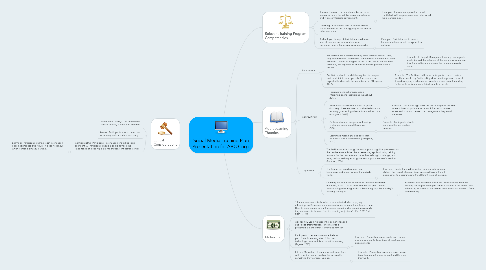
1. Adult Learning Theories
1.1. Behaviorism
1.1.1. Tell learners the outcome so they know what to expect. Also, they can decide for themselves if the desired outcome has been achieved. Project Managers of ABC Corp. would be informed what they are expected to know and how to perform certain actions.
1.1.1.1. Example: In Project Management training, participants would be told the outcome of the training is to manage their time better and manage their project budgets better.
1.1.2. Facilitators should model the required techniques and break it into small parts before learners are expected to duplicate the same behavior (Alzaghoul, 2013).
1.1.2.1. Example: The facilitator will show participants how to create a weekly schedule, by first breaking down what happens in a week, then developing a schedule using columns and rows, then filling in the table to form a completed sample schedule.
1.2. Constructivism
1.2.1. Facilitators should provide good interactive online instructions (Alzaghoul, 2013).
1.2.2. Facilitators should have a form of guided discovery. Learners need to make decisions on learning goals with guidance from the instructor (Alzaghoul, 2013).
1.2.2.1. Example: While making schedules the participants can see where missed appointments or lost information causes stress and how with better time management they avoid the stress.
1.2.3. Collaborative and cooperative learning is strongly encouraged (Alzaghoul, 2013).
1.2.3.1. Example: Participants should work together on creating budgets.
1.2.4. Learning is meaningful and sees each learner as a unique individual (Alzaghoul, 2013).
1.3. Cognitivism
1.3.1. The facilitator's role is to guide and support cognitive processes and this can be accomplished by an e-learning application by helping learners link the new information to their existing knowledge, and using various techniques to guide and support learners’ attention (Brandon, 2004).
1.3.2. The learner is viewed as receiving knowledge and meaning from the outside world.
1.3.2.1. Example: Content should be written to align with learning styles. The Project Manager training should have different approaches to accommodate the different ways of learning,
1.3.3. Currently the dominant influence on instructional design (Brandon, 2004). This is because it makes great use on incorporating e-learning, which is becoming popular in today's learning strategies.
1.3.3.1. Example: Use multimedia to make use of working memory. Training for project managers can use pictures, slide shows, and scheduling software so the learner can store it and access it from their memory.
2. Motivation
2.1. "Students are more likely to be more motivated when applying e-learning, so If students are more motivated to learn, then they are more likely to be engaged; and if they are engaged and engaged successfully, they are more likely to achieve the learning objectives" ( Kim & W. Frick, 2011, p. 20).
2.2. Attention: E-Learning keeps the learner engaged and keeps their attention. The material is presented a manner that is lively and familiar.
2.3. Participation: Learners are more likely to participate in learning when it involves technology because it is more active learning (Rajaee, 2015).
2.3.1. Example: Project Managers would learn to use google calendar to keep track of meetings and appointments.
2.4. Intrinsic Motivation: Learning is motivated from within, so the learner involves his or herself in something they consider unique.
2.4.1. Example: Project Managers are eager to use tools learned in training to see the difference in their work.
3. Ethical Considerations
3.1. Information Quality: The information should be true, current, and credible.
3.2. Access: Participants should be access to learning materials when necessary.
3.3. Confidentiality: Participants' information should be kept confidential. Participants should also be advised the importance of keeping login information confidential as well.
3.3.1. Example: Participants sharing login information does not produce true results. It does not show which learner is actually learning.
4. Relevant Training Program Competencies
4.1. Training Delivery: Training should be delivered in easy to follow format, be engaging, relevant, and in an comfortable environment.
4.1.1. Example: Training in a space that is well ventilated, with ample space, and lighting will help learners excel.
4.2. Coaching: A facilitator should be available to coach learners as the training progresses and to offer assistance.
4.3. Technology Literacy: A facilitator should make sure all learners are comfortable using technology and offer assistance when needed.
4.3.1. Example: Facilitator has to ensure learners are familiar with equipment or software.
